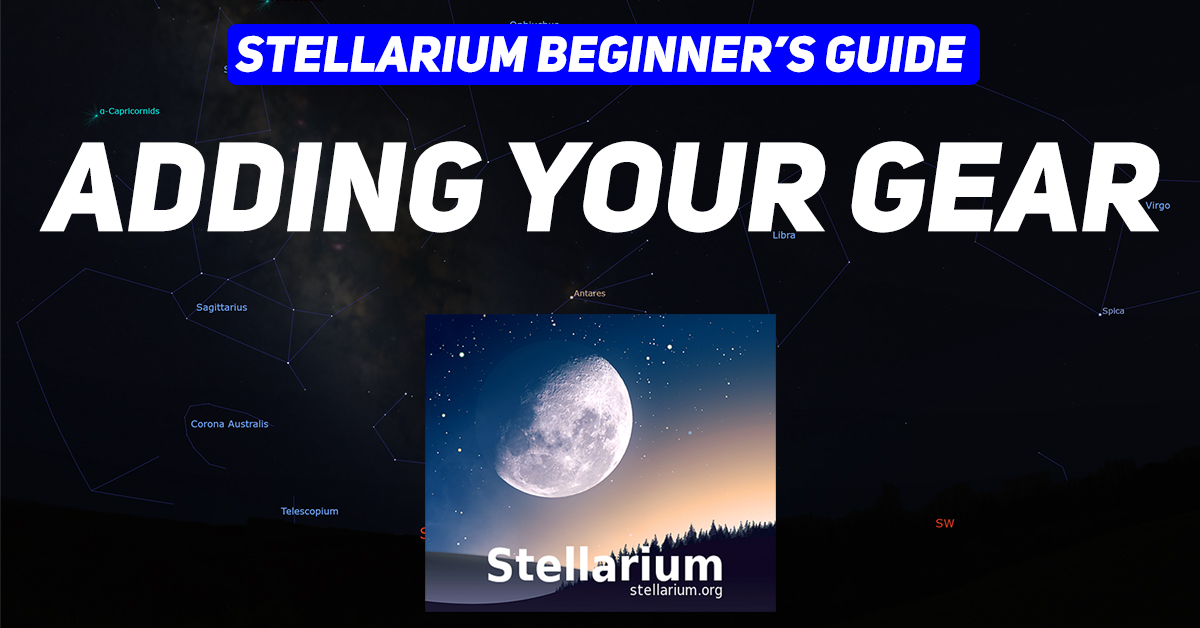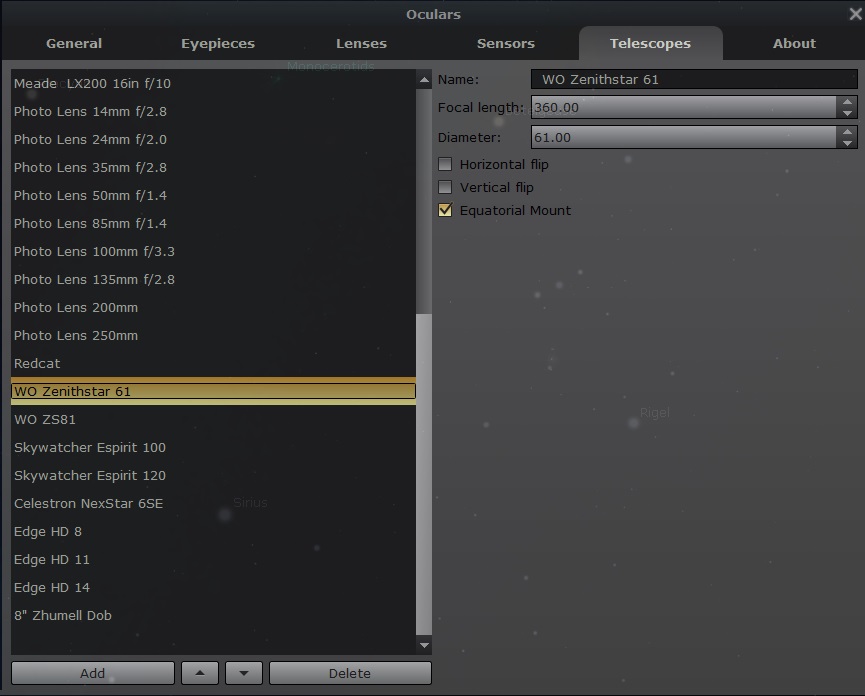How to Add Your Gear to Stellarium

Introduction
When first using Stellarium, it comes with quite a few telescope, eyepiece, and camera options. However, it’s impossible to include every variation out there by default. Would you like to know how to add your own gear to Stellarium?
Below you’ll find my guide to adding your gear. If you follow the steps below, you’ll be able to tell what objects will look like with your specific combination of gear. Fortunately, it’s very easy to do.
Getting Started
Before adding your gear, go to the manufacturer’s website or a store website to look for the specifications for each item.
Tip: There are a small number of manufacturers of telescope components worldwide. If you can’t find specifications for your brand, look for another that looks exactly like it. For example, the below Zhumell 30mm eyepiece is actually a GSO eyepiece with Zhumell branding.
{eyepiece image}
It might take some digging if websites aren’t forthcoming with the specifications, but you can usually find them fairly easily.
Specs You’ll Need
Eyepieces: Apparent Field of View (aFOV) and Focal Length
Telescopes and DSLR Lens: Diameter and Focal Length.
For DSLR Lenses: The diameter listed on most websites is related to the size of filter you need, if you plan on using a filter for daytime use, it is not the diameter needed for Stellarium. To get an accurate diameter, you’ll want to use this formula: Focal Length / f-stop = Diameter. You’ll want to round to the nearest hundredth.
An example for the Rokinon 135mm lens: 135/ 2.8 = 48.20. If you are using a zoom/telephoto lens, this matters since zooming does change the diameter of view. An example would be using a 70-300mm 4-5.6 lens, stopped down once to get sharper stars. At 70 mm, the math would be: 70/4.5= 15.60 . At 300 mm, the same lens would appear different: 300/6.3 = 47.62
Special Note: I did not know the above formula when I recorded the video, please do use the formula for an accurate representation of your field of view.
Cameras: For both dedicated astrophotography cameras and DSLR cameras, you will need the Resolution (x/y) in pixels and the chip width and height in millimeters.
Adding the Gear to Stellarium
When adding gear to Stellarium, you will use the Oculars configuration windows, which can be opened in the upper right of the screen.

Eyepiece Tab
In the eyepiece list, go to the bottom and click “Add.” You can name the eyepiece whatever you want, but it is easier to name it whatever it actually is. For example: Zhumell 30mm. Next, you’ll want to add in the values from the manufacturer’s website.
Hit enter after typing the number to save, there is no save button. That’s all there is to it!

Lens Tab
The lens tab is for Barlow lenses and focal reducers. If you require these with your setup, you’ll add it here.
Telescopes Tab
The telescopes tab is where you will add in your telescopes, or if you are using a DSLR lens you’ll add it here.
To add your telescope or lens, click the telescopes tab, then click “Add.” Name the telescope whatever you want, just like above with eyepieces, and add in the values.
Hit enter after typing the number to save. Note: If it’s a reflector, make sure you check the flips boxes so it looks appropriate when using visual observing previews.
Last step here, make sure you check Equatorial mount if that’s what your scope is on.

Cameras
Cameras are the last thing to add. To add them, go to the “Sensors” tab and click “Add.”
Name the camera and add in the values
Note: If you see a section for Pixel width and height in microns (weird µm measurement), it is NO LONGER NEEDED. If you see this measurement in Stellarium, update it. Stellarium now does the math needed to get these values based on the other values you’ve entered. For some cameras it’s not easy finding the micron measurement, so using an updated version of Stellarium will save sometime.
Hit enter after typing the number to save.
That’s it! Repeat as necessary for any other gear you may need to add.

After adding everything, you can close the window. Based on what you are doing, you can click on the ocular view to view your eyepiece/telescope combination.
Alternatively, if you are imaging, click on the sensor icon and cycle through to your combination to see how things look framed up.
Conclusion
Stellarium is an amazing free planetarium software that has many other uses to help you plan for a night out. You’ve successfully added your gear to Stellarium, but what about other things? If you haven’t yet, please check out the landscape guide to help show what your location looks like at any given time of the year. Or, if you have a few images of nebulae or galaxies you’d like to see in Stellarium, check out the how to add images to Stellarium guide.
If you prefer the video version, you can check out my guide on Youtube below, but please do take note of the formula for DSLR lenses listed in the Specs section above:
I have a question about entering my gear into Stellarium. I will be photographing various celestial objects with my DSLR and telephoto lens mounted on a tripod. I am not using a telescope eyepiece. How do I handle the eyepiece selection in Stellarium in order to get the correct FOV? Unlike for “Lens”, there appears to be no way to select “None” for eyepiece.
You would need to put it in the telescopes section. As long as you have the focal length and the diameter, which you usually find on the manufacturer’s website, you’ll get the correct FOV.
Dear astroescape.com webmaster, Your posts are always well-referenced and credible.
Thank you!
Hello, I’m following up on Dennis’ question about setting up camera gear in Stellarium. I’ve scoured the user guide and watched a handful of videos, and I think I’ve got it, but I’m not 100% sure. Thanks for answering Dennis’ question because this addresses mine as well. I have a couple of questions to help clarify.
It seems there’s a default value in eyepieces. If I’m not using one (Canon eos r5 with Sigma 150-600mm lens), will having the default value in eyepieces change anything? Maybe I should delete all entries in this section?
I added my lens in the Telescopes tab – for diameter should I use the filter-thread diameter? For this lens, it’s 95mm – that the size of threaded filters it uses.
I entered a few instances of the lens with different focal lengths. I’m assuming I can set the lens at 400mm for example, and enter that value to get a representation of what the frame will look like.
Thanks for the help!
I have a quick question regarding using dslr with a cropped sensor… I am using a Nikon D5100 along with a Samyang 135mm lens. I have entered the equipment and specs into Stellarium. If I enter the actual focal length of the lens and the camera sensor specs, will Stellarium calculate the effective focal length of the lens? Or should I enter the effective focal length (206.5mm) as the focal length? Thanks.